CIO Report: Cybercrime Risk Mitigation for New Threats of 2018
VerifiedAdded on 2023/06/14
|15
|4390
|358
Report
AI Summary
This report provides an analysis of cybercrime risk mitigation strategies for the emerging threats of 2018, targeted towards a Chief Information Officer (CIO) audience. It begins with an introduction and background on cybercrime, discussing its evolution from early hacking incidents to modern-day sophisticated attacks. The report then outlines the requirements and choices involved in risk assessment, detailing a six-step process including system characterization, threat identification, risk prioritization, control environment analysis, likelihood rating determination, and risk rating calculation. The discussion section highlights new cyber threats of 2018 such as data breaching, cloud ransomware, and AI weaponization, further elaborating on risk mitigation technologies available to combat these threats like data encryption, firewalls, and intrusion detection systems. The report concludes by summarizing key findings and providing recommendations for effective cybercrime risk mitigation, emphasizing the importance of proactive measures and continuous monitoring to safeguard organizational assets. Desklib provides solved assignments for students.
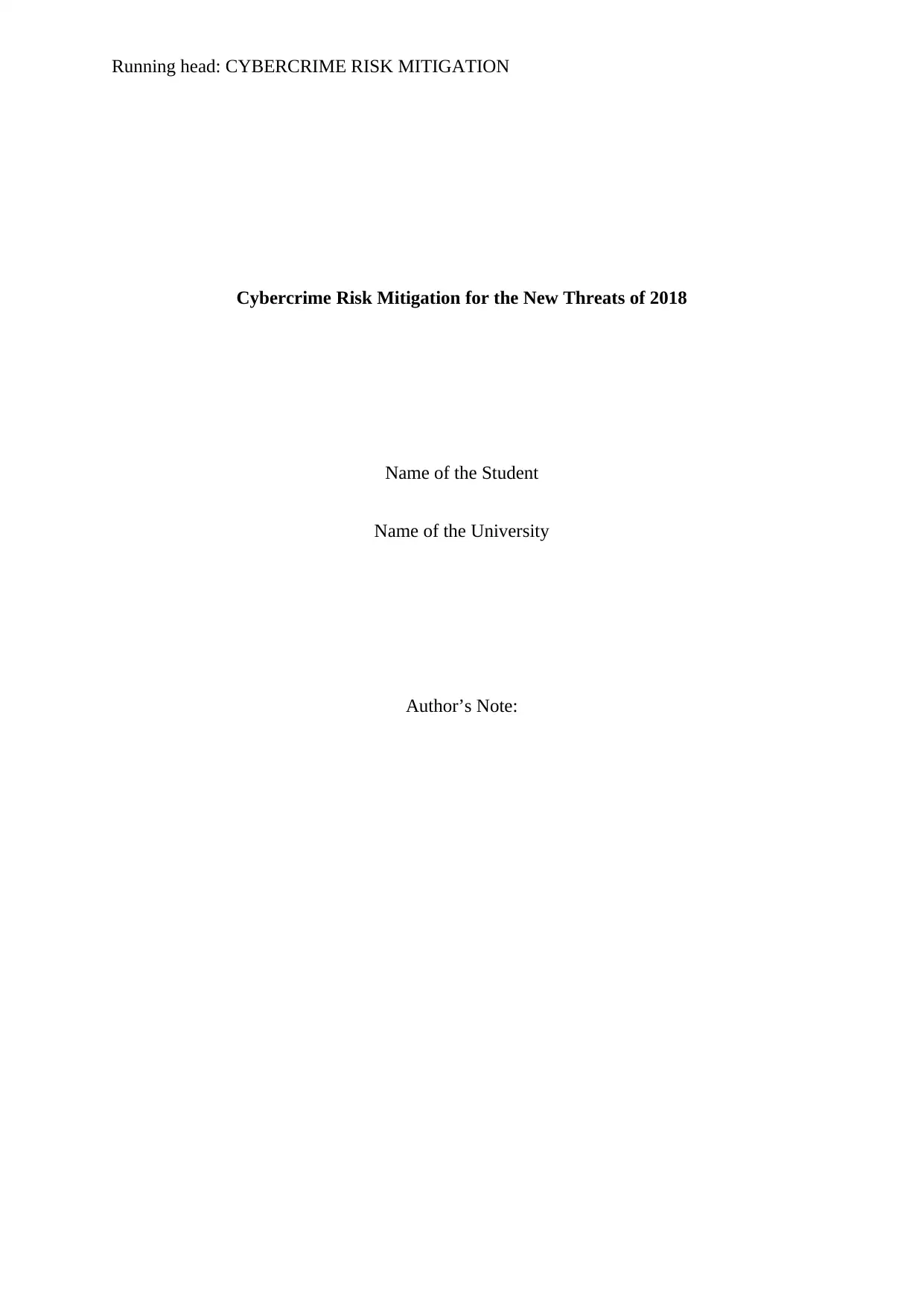
Running head: CYBERCRIME RISK MITIGATION
Cybercrime Risk Mitigation for the New Threats of 2018
Name of the Student
Name of the University
Author’s Note:
Cybercrime Risk Mitigation for the New Threats of 2018
Name of the Student
Name of the University
Author’s Note:
Paraphrase This Document
Need a fresh take? Get an instant paraphrase of this document with our AI Paraphraser
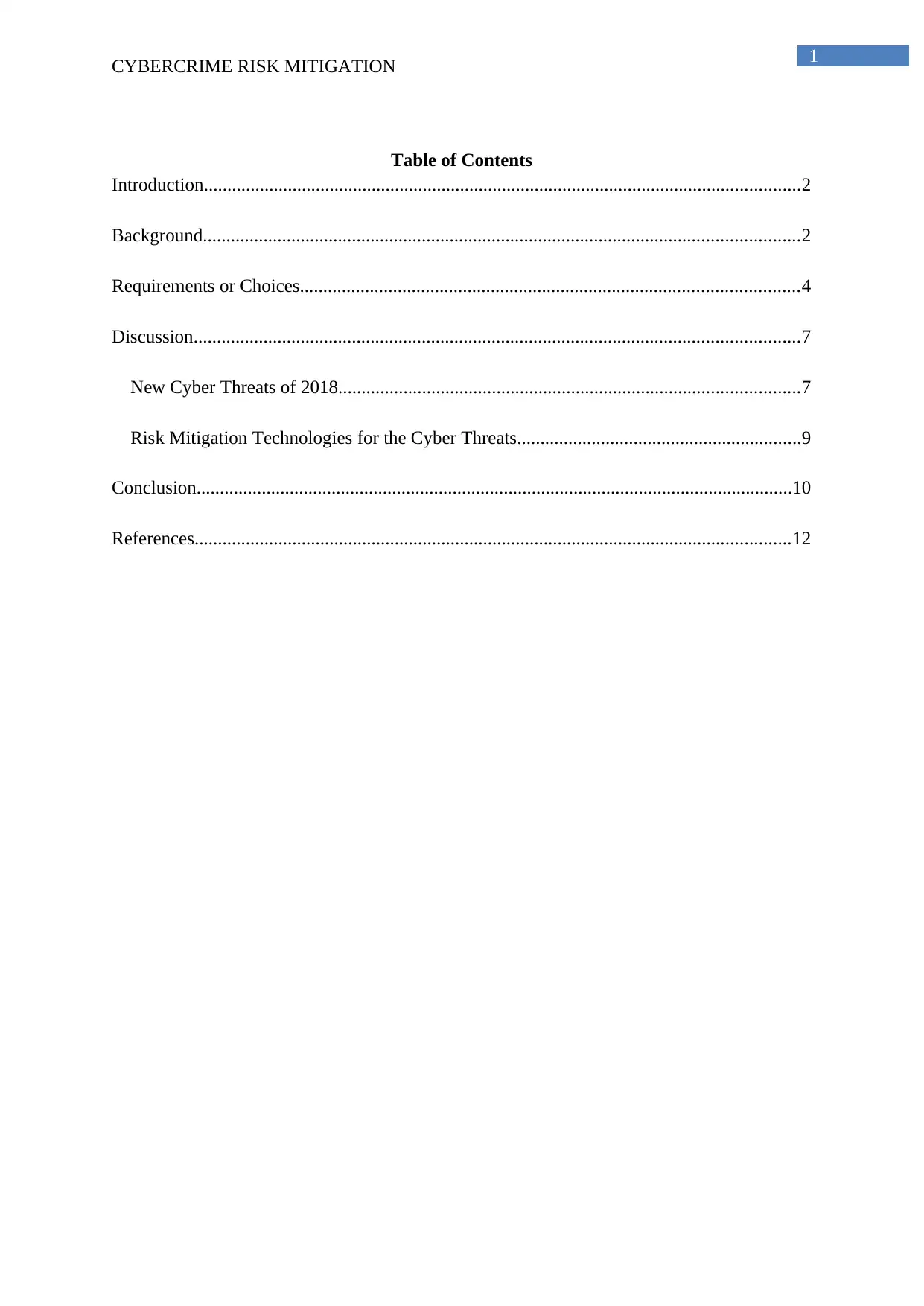
1
CYBERCRIME RISK MITIGATION
Table of Contents
Introduction................................................................................................................................2
Background................................................................................................................................2
Requirements or Choices...........................................................................................................4
Discussion..................................................................................................................................7
New Cyber Threats of 2018...................................................................................................7
Risk Mitigation Technologies for the Cyber Threats.............................................................9
Conclusion................................................................................................................................10
References................................................................................................................................12
CYBERCRIME RISK MITIGATION
Table of Contents
Introduction................................................................................................................................2
Background................................................................................................................................2
Requirements or Choices...........................................................................................................4
Discussion..................................................................................................................................7
New Cyber Threats of 2018...................................................................................................7
Risk Mitigation Technologies for the Cyber Threats.............................................................9
Conclusion................................................................................................................................10
References................................................................................................................................12
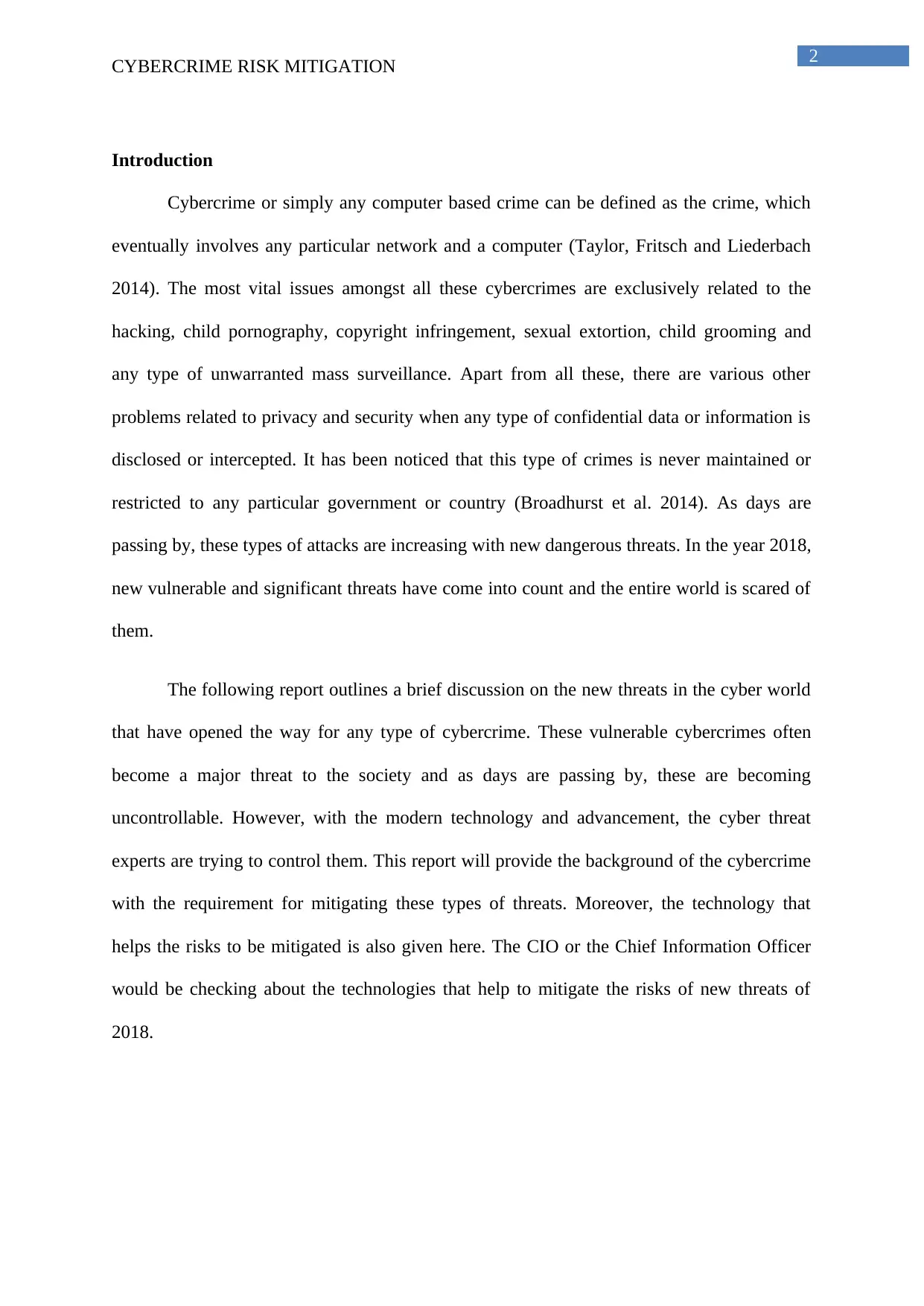
2
CYBERCRIME RISK MITIGATION
Introduction
Cybercrime or simply any computer based crime can be defined as the crime, which
eventually involves any particular network and a computer (Taylor, Fritsch and Liederbach
2014). The most vital issues amongst all these cybercrimes are exclusively related to the
hacking, child pornography, copyright infringement, sexual extortion, child grooming and
any type of unwarranted mass surveillance. Apart from all these, there are various other
problems related to privacy and security when any type of confidential data or information is
disclosed or intercepted. It has been noticed that this type of crimes is never maintained or
restricted to any particular government or country (Broadhurst et al. 2014). As days are
passing by, these types of attacks are increasing with new dangerous threats. In the year 2018,
new vulnerable and significant threats have come into count and the entire world is scared of
them.
The following report outlines a brief discussion on the new threats in the cyber world
that have opened the way for any type of cybercrime. These vulnerable cybercrimes often
become a major threat to the society and as days are passing by, these are becoming
uncontrollable. However, with the modern technology and advancement, the cyber threat
experts are trying to control them. This report will provide the background of the cybercrime
with the requirement for mitigating these types of threats. Moreover, the technology that
helps the risks to be mitigated is also given here. The CIO or the Chief Information Officer
would be checking about the technologies that help to mitigate the risks of new threats of
2018.
CYBERCRIME RISK MITIGATION
Introduction
Cybercrime or simply any computer based crime can be defined as the crime, which
eventually involves any particular network and a computer (Taylor, Fritsch and Liederbach
2014). The most vital issues amongst all these cybercrimes are exclusively related to the
hacking, child pornography, copyright infringement, sexual extortion, child grooming and
any type of unwarranted mass surveillance. Apart from all these, there are various other
problems related to privacy and security when any type of confidential data or information is
disclosed or intercepted. It has been noticed that this type of crimes is never maintained or
restricted to any particular government or country (Broadhurst et al. 2014). As days are
passing by, these types of attacks are increasing with new dangerous threats. In the year 2018,
new vulnerable and significant threats have come into count and the entire world is scared of
them.
The following report outlines a brief discussion on the new threats in the cyber world
that have opened the way for any type of cybercrime. These vulnerable cybercrimes often
become a major threat to the society and as days are passing by, these are becoming
uncontrollable. However, with the modern technology and advancement, the cyber threat
experts are trying to control them. This report will provide the background of the cybercrime
with the requirement for mitigating these types of threats. Moreover, the technology that
helps the risks to be mitigated is also given here. The CIO or the Chief Information Officer
would be checking about the technologies that help to mitigate the risks of new threats of
2018.
⊘ This is a preview!⊘
Do you want full access?
Subscribe today to unlock all pages.

Trusted by 1+ million students worldwide
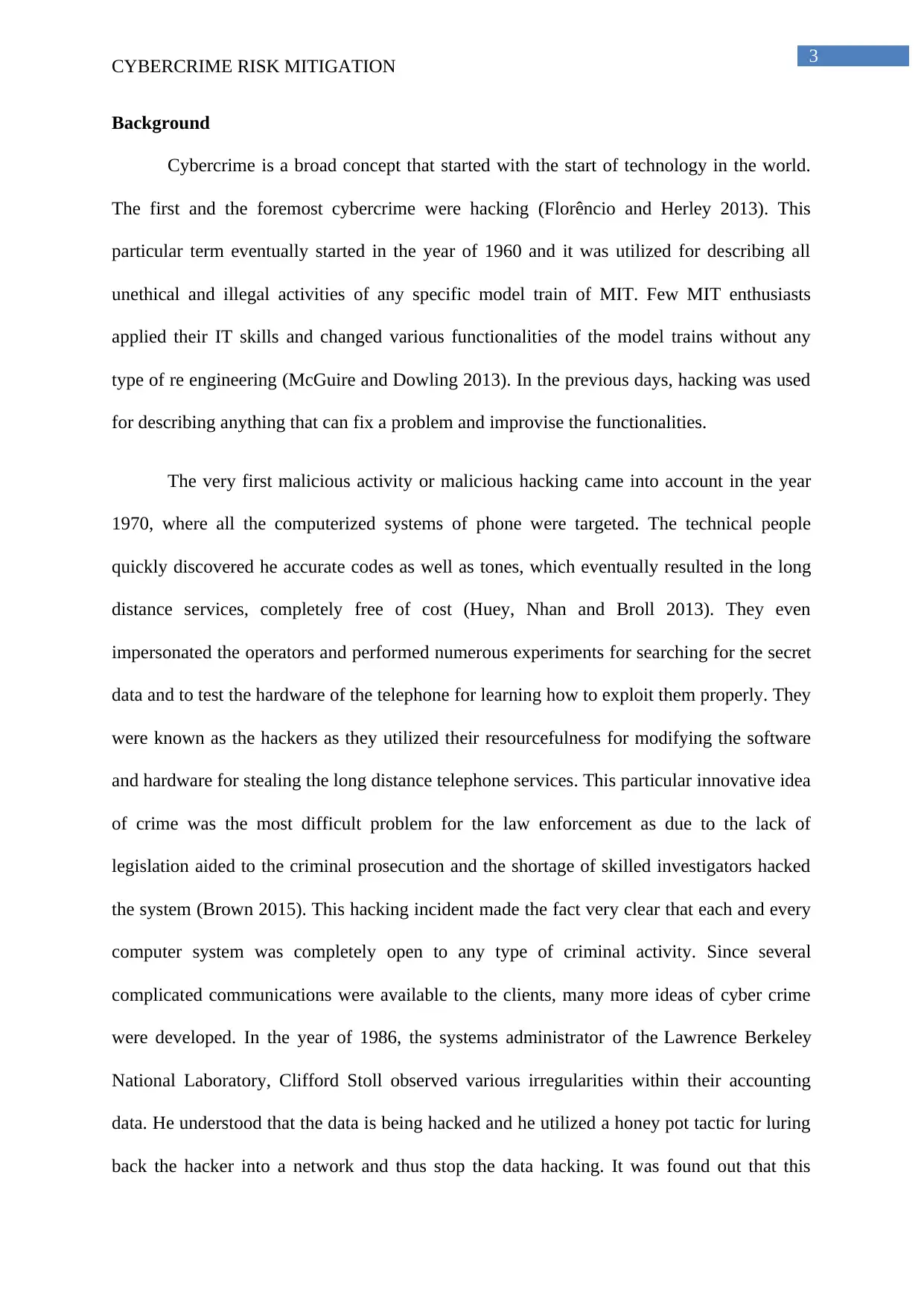
3
CYBERCRIME RISK MITIGATION
Background
Cybercrime is a broad concept that started with the start of technology in the world.
The first and the foremost cybercrime were hacking (Florêncio and Herley 2013). This
particular term eventually started in the year of 1960 and it was utilized for describing all
unethical and illegal activities of any specific model train of MIT. Few MIT enthusiasts
applied their IT skills and changed various functionalities of the model trains without any
type of re engineering (McGuire and Dowling 2013). In the previous days, hacking was used
for describing anything that can fix a problem and improvise the functionalities.
The very first malicious activity or malicious hacking came into account in the year
1970, where all the computerized systems of phone were targeted. The technical people
quickly discovered he accurate codes as well as tones, which eventually resulted in the long
distance services, completely free of cost (Huey, Nhan and Broll 2013). They even
impersonated the operators and performed numerous experiments for searching for the secret
data and to test the hardware of the telephone for learning how to exploit them properly. They
were known as the hackers as they utilized their resourcefulness for modifying the software
and hardware for stealing the long distance telephone services. This particular innovative idea
of crime was the most difficult problem for the law enforcement as due to the lack of
legislation aided to the criminal prosecution and the shortage of skilled investigators hacked
the system (Brown 2015). This hacking incident made the fact very clear that each and every
computer system was completely open to any type of criminal activity. Since several
complicated communications were available to the clients, many more ideas of cyber crime
were developed. In the year of 1986, the systems administrator of the Lawrence Berkeley
National Laboratory, Clifford Stoll observed various irregularities within their accounting
data. He understood that the data is being hacked and he utilized a honey pot tactic for luring
back the hacker into a network and thus stop the data hacking. It was found out that this
CYBERCRIME RISK MITIGATION
Background
Cybercrime is a broad concept that started with the start of technology in the world.
The first and the foremost cybercrime were hacking (Florêncio and Herley 2013). This
particular term eventually started in the year of 1960 and it was utilized for describing all
unethical and illegal activities of any specific model train of MIT. Few MIT enthusiasts
applied their IT skills and changed various functionalities of the model trains without any
type of re engineering (McGuire and Dowling 2013). In the previous days, hacking was used
for describing anything that can fix a problem and improvise the functionalities.
The very first malicious activity or malicious hacking came into account in the year
1970, where all the computerized systems of phone were targeted. The technical people
quickly discovered he accurate codes as well as tones, which eventually resulted in the long
distance services, completely free of cost (Huey, Nhan and Broll 2013). They even
impersonated the operators and performed numerous experiments for searching for the secret
data and to test the hardware of the telephone for learning how to exploit them properly. They
were known as the hackers as they utilized their resourcefulness for modifying the software
and hardware for stealing the long distance telephone services. This particular innovative idea
of crime was the most difficult problem for the law enforcement as due to the lack of
legislation aided to the criminal prosecution and the shortage of skilled investigators hacked
the system (Brown 2015). This hacking incident made the fact very clear that each and every
computer system was completely open to any type of criminal activity. Since several
complicated communications were available to the clients, many more ideas of cyber crime
were developed. In the year of 1986, the systems administrator of the Lawrence Berkeley
National Laboratory, Clifford Stoll observed various irregularities within their accounting
data. He understood that the data is being hacked and he utilized a honey pot tactic for luring
back the hacker into a network and thus stop the data hacking. It was found out that this
Paraphrase This Document
Need a fresh take? Get an instant paraphrase of this document with our AI Paraphraser
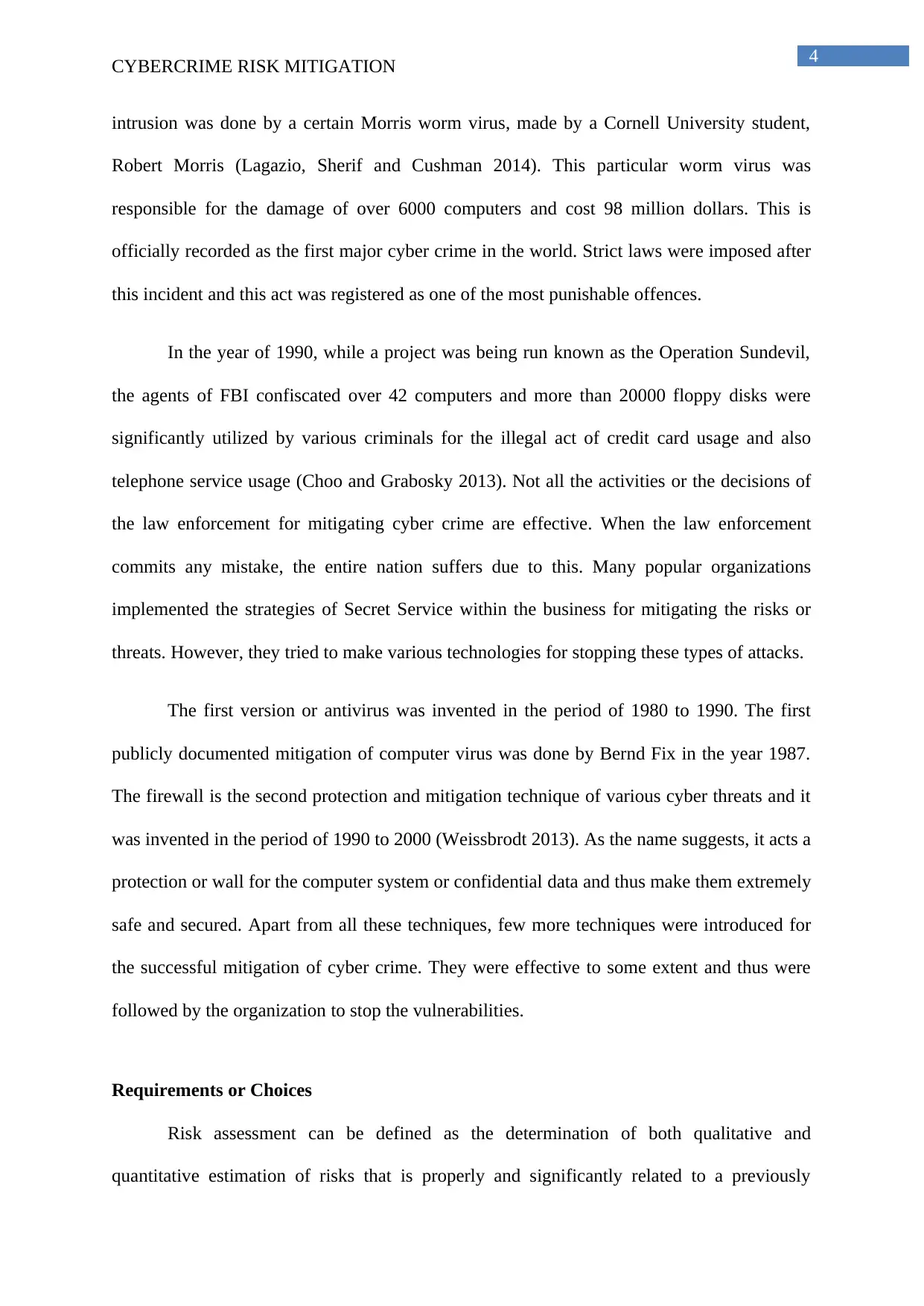
4
CYBERCRIME RISK MITIGATION
intrusion was done by a certain Morris worm virus, made by a Cornell University student,
Robert Morris (Lagazio, Sherif and Cushman 2014). This particular worm virus was
responsible for the damage of over 6000 computers and cost 98 million dollars. This is
officially recorded as the first major cyber crime in the world. Strict laws were imposed after
this incident and this act was registered as one of the most punishable offences.
In the year of 1990, while a project was being run known as the Operation Sundevil,
the agents of FBI confiscated over 42 computers and more than 20000 floppy disks were
significantly utilized by various criminals for the illegal act of credit card usage and also
telephone service usage (Choo and Grabosky 2013). Not all the activities or the decisions of
the law enforcement for mitigating cyber crime are effective. When the law enforcement
commits any mistake, the entire nation suffers due to this. Many popular organizations
implemented the strategies of Secret Service within the business for mitigating the risks or
threats. However, they tried to make various technologies for stopping these types of attacks.
The first version or antivirus was invented in the period of 1980 to 1990. The first
publicly documented mitigation of computer virus was done by Bernd Fix in the year 1987.
The firewall is the second protection and mitigation technique of various cyber threats and it
was invented in the period of 1990 to 2000 (Weissbrodt 2013). As the name suggests, it acts a
protection or wall for the computer system or confidential data and thus make them extremely
safe and secured. Apart from all these techniques, few more techniques were introduced for
the successful mitigation of cyber crime. They were effective to some extent and thus were
followed by the organization to stop the vulnerabilities.
Requirements or Choices
Risk assessment can be defined as the determination of both qualitative and
quantitative estimation of risks that is properly and significantly related to a previously
CYBERCRIME RISK MITIGATION
intrusion was done by a certain Morris worm virus, made by a Cornell University student,
Robert Morris (Lagazio, Sherif and Cushman 2014). This particular worm virus was
responsible for the damage of over 6000 computers and cost 98 million dollars. This is
officially recorded as the first major cyber crime in the world. Strict laws were imposed after
this incident and this act was registered as one of the most punishable offences.
In the year of 1990, while a project was being run known as the Operation Sundevil,
the agents of FBI confiscated over 42 computers and more than 20000 floppy disks were
significantly utilized by various criminals for the illegal act of credit card usage and also
telephone service usage (Choo and Grabosky 2013). Not all the activities or the decisions of
the law enforcement for mitigating cyber crime are effective. When the law enforcement
commits any mistake, the entire nation suffers due to this. Many popular organizations
implemented the strategies of Secret Service within the business for mitigating the risks or
threats. However, they tried to make various technologies for stopping these types of attacks.
The first version or antivirus was invented in the period of 1980 to 1990. The first
publicly documented mitigation of computer virus was done by Bernd Fix in the year 1987.
The firewall is the second protection and mitigation technique of various cyber threats and it
was invented in the period of 1990 to 2000 (Weissbrodt 2013). As the name suggests, it acts a
protection or wall for the computer system or confidential data and thus make them extremely
safe and secured. Apart from all these techniques, few more techniques were introduced for
the successful mitigation of cyber crime. They were effective to some extent and thus were
followed by the organization to stop the vulnerabilities.
Requirements or Choices
Risk assessment can be defined as the determination of both qualitative and
quantitative estimation of risks that is properly and significantly related to a previously
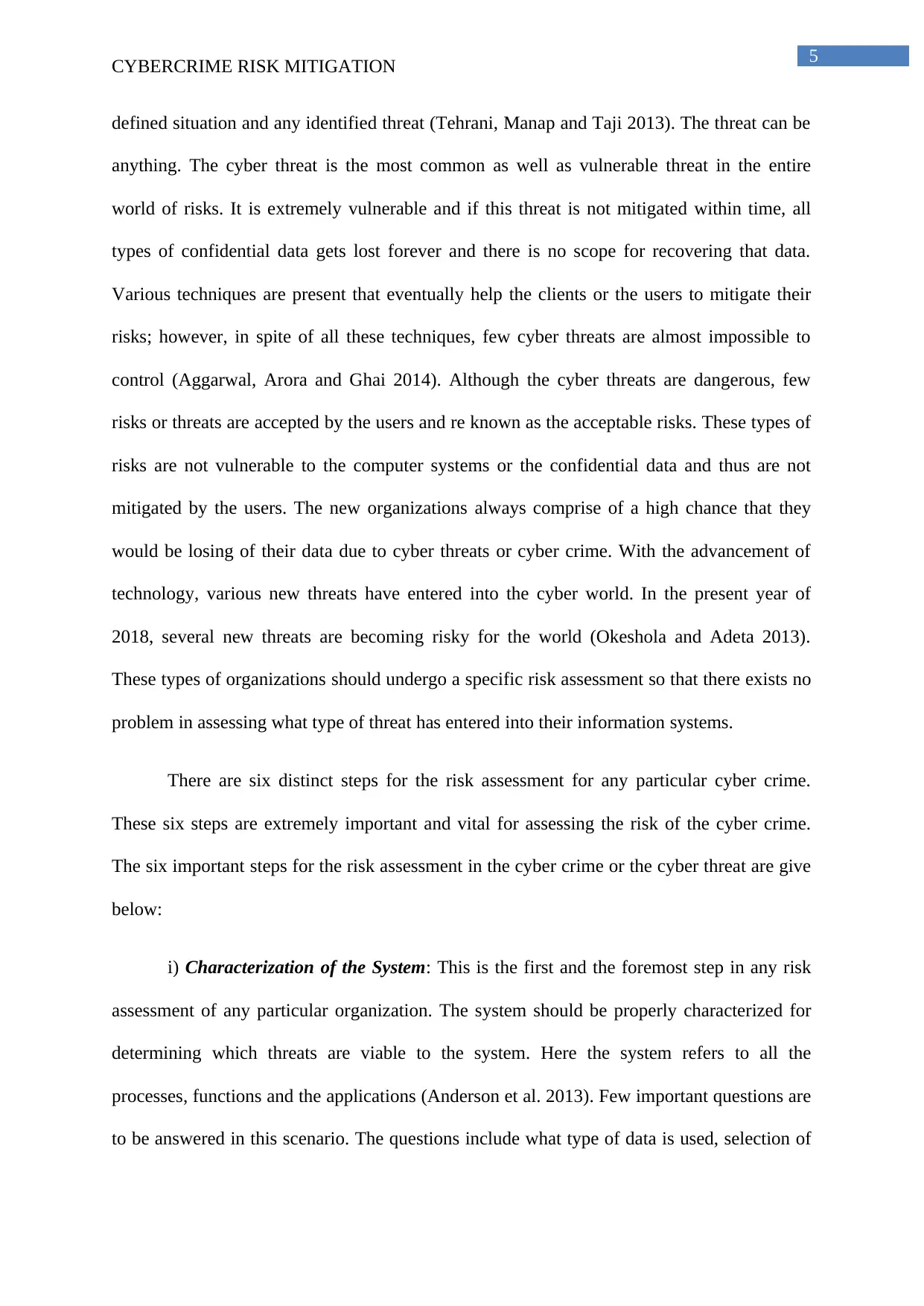
5
CYBERCRIME RISK MITIGATION
defined situation and any identified threat (Tehrani, Manap and Taji 2013). The threat can be
anything. The cyber threat is the most common as well as vulnerable threat in the entire
world of risks. It is extremely vulnerable and if this threat is not mitigated within time, all
types of confidential data gets lost forever and there is no scope for recovering that data.
Various techniques are present that eventually help the clients or the users to mitigate their
risks; however, in spite of all these techniques, few cyber threats are almost impossible to
control (Aggarwal, Arora and Ghai 2014). Although the cyber threats are dangerous, few
risks or threats are accepted by the users and re known as the acceptable risks. These types of
risks are not vulnerable to the computer systems or the confidential data and thus are not
mitigated by the users. The new organizations always comprise of a high chance that they
would be losing of their data due to cyber threats or cyber crime. With the advancement of
technology, various new threats have entered into the cyber world. In the present year of
2018, several new threats are becoming risky for the world (Okeshola and Adeta 2013).
These types of organizations should undergo a specific risk assessment so that there exists no
problem in assessing what type of threat has entered into their information systems.
There are six distinct steps for the risk assessment for any particular cyber crime.
These six steps are extremely important and vital for assessing the risk of the cyber crime.
The six important steps for the risk assessment in the cyber crime or the cyber threat are give
below:
i) Characterization of the System: This is the first and the foremost step in any risk
assessment of any particular organization. The system should be properly characterized for
determining which threats are viable to the system. Here the system refers to all the
processes, functions and the applications (Anderson et al. 2013). Few important questions are
to be answered in this scenario. The questions include what type of data is used, selection of
CYBERCRIME RISK MITIGATION
defined situation and any identified threat (Tehrani, Manap and Taji 2013). The threat can be
anything. The cyber threat is the most common as well as vulnerable threat in the entire
world of risks. It is extremely vulnerable and if this threat is not mitigated within time, all
types of confidential data gets lost forever and there is no scope for recovering that data.
Various techniques are present that eventually help the clients or the users to mitigate their
risks; however, in spite of all these techniques, few cyber threats are almost impossible to
control (Aggarwal, Arora and Ghai 2014). Although the cyber threats are dangerous, few
risks or threats are accepted by the users and re known as the acceptable risks. These types of
risks are not vulnerable to the computer systems or the confidential data and thus are not
mitigated by the users. The new organizations always comprise of a high chance that they
would be losing of their data due to cyber threats or cyber crime. With the advancement of
technology, various new threats have entered into the cyber world. In the present year of
2018, several new threats are becoming risky for the world (Okeshola and Adeta 2013).
These types of organizations should undergo a specific risk assessment so that there exists no
problem in assessing what type of threat has entered into their information systems.
There are six distinct steps for the risk assessment for any particular cyber crime.
These six steps are extremely important and vital for assessing the risk of the cyber crime.
The six important steps for the risk assessment in the cyber crime or the cyber threat are give
below:
i) Characterization of the System: This is the first and the foremost step in any risk
assessment of any particular organization. The system should be properly characterized for
determining which threats are viable to the system. Here the system refers to all the
processes, functions and the applications (Anderson et al. 2013). Few important questions are
to be answered in this scenario. The questions include what type of data is used, selection of
⊘ This is a preview!⊘
Do you want full access?
Subscribe today to unlock all pages.

Trusted by 1+ million students worldwide
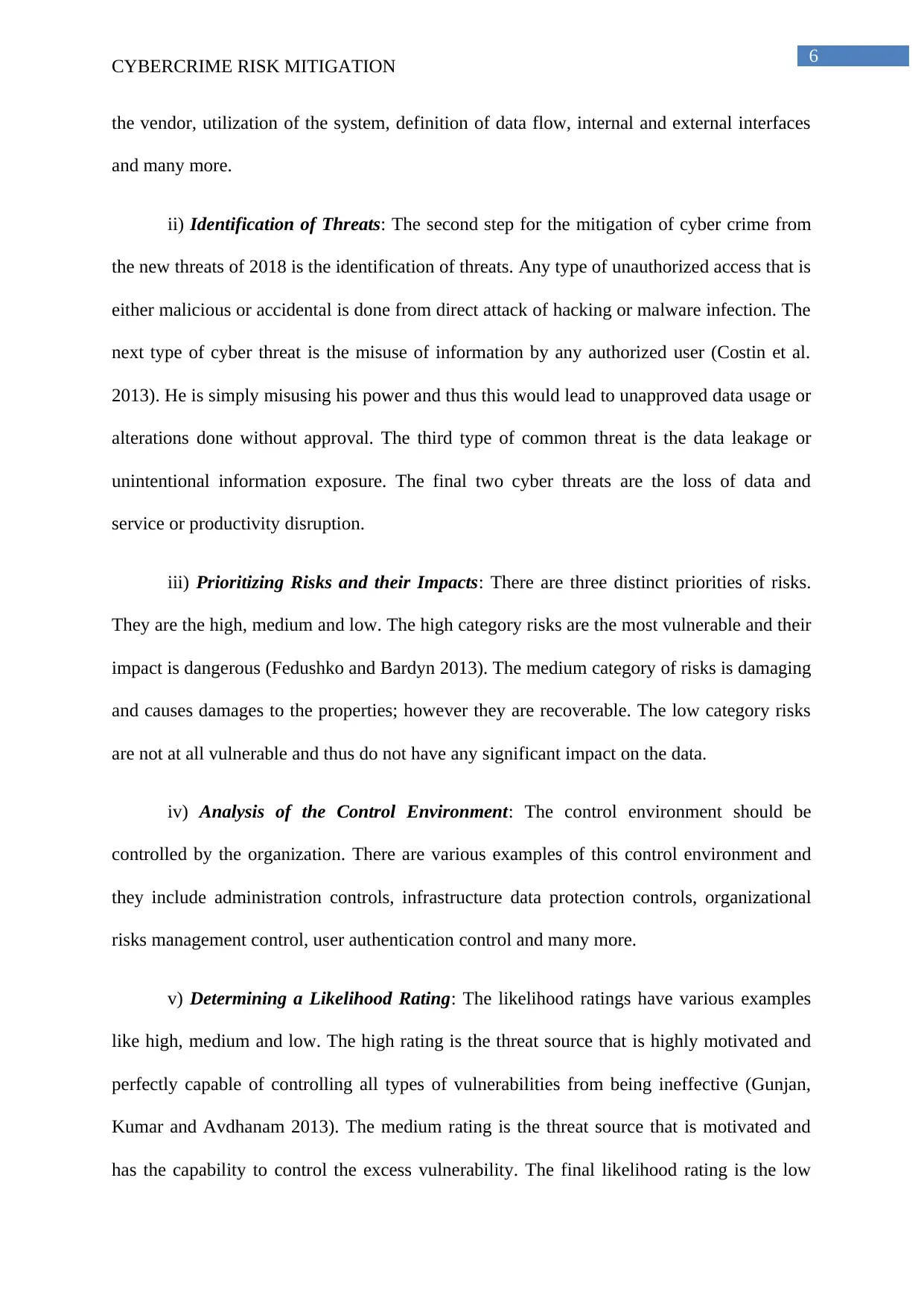
6
CYBERCRIME RISK MITIGATION
the vendor, utilization of the system, definition of data flow, internal and external interfaces
and many more.
ii) Identification of Threats: The second step for the mitigation of cyber crime from
the new threats of 2018 is the identification of threats. Any type of unauthorized access that is
either malicious or accidental is done from direct attack of hacking or malware infection. The
next type of cyber threat is the misuse of information by any authorized user (Costin et al.
2013). He is simply misusing his power and thus this would lead to unapproved data usage or
alterations done without approval. The third type of common threat is the data leakage or
unintentional information exposure. The final two cyber threats are the loss of data and
service or productivity disruption.
iii) Prioritizing Risks and their Impacts: There are three distinct priorities of risks.
They are the high, medium and low. The high category risks are the most vulnerable and their
impact is dangerous (Fedushko and Bardyn 2013). The medium category of risks is damaging
and causes damages to the properties; however they are recoverable. The low category risks
are not at all vulnerable and thus do not have any significant impact on the data.
iv) Analysis of the Control Environment: The control environment should be
controlled by the organization. There are various examples of this control environment and
they include administration controls, infrastructure data protection controls, organizational
risks management control, user authentication control and many more.
v) Determining a Likelihood Rating: The likelihood ratings have various examples
like high, medium and low. The high rating is the threat source that is highly motivated and
perfectly capable of controlling all types of vulnerabilities from being ineffective (Gunjan,
Kumar and Avdhanam 2013). The medium rating is the threat source that is motivated and
has the capability to control the excess vulnerability. The final likelihood rating is the low
CYBERCRIME RISK MITIGATION
the vendor, utilization of the system, definition of data flow, internal and external interfaces
and many more.
ii) Identification of Threats: The second step for the mitigation of cyber crime from
the new threats of 2018 is the identification of threats. Any type of unauthorized access that is
either malicious or accidental is done from direct attack of hacking or malware infection. The
next type of cyber threat is the misuse of information by any authorized user (Costin et al.
2013). He is simply misusing his power and thus this would lead to unapproved data usage or
alterations done without approval. The third type of common threat is the data leakage or
unintentional information exposure. The final two cyber threats are the loss of data and
service or productivity disruption.
iii) Prioritizing Risks and their Impacts: There are three distinct priorities of risks.
They are the high, medium and low. The high category risks are the most vulnerable and their
impact is dangerous (Fedushko and Bardyn 2013). The medium category of risks is damaging
and causes damages to the properties; however they are recoverable. The low category risks
are not at all vulnerable and thus do not have any significant impact on the data.
iv) Analysis of the Control Environment: The control environment should be
controlled by the organization. There are various examples of this control environment and
they include administration controls, infrastructure data protection controls, organizational
risks management control, user authentication control and many more.
v) Determining a Likelihood Rating: The likelihood ratings have various examples
like high, medium and low. The high rating is the threat source that is highly motivated and
perfectly capable of controlling all types of vulnerabilities from being ineffective (Gunjan,
Kumar and Avdhanam 2013). The medium rating is the threat source that is motivated and
has the capability to control the excess vulnerability. The final likelihood rating is the low
Paraphrase This Document
Need a fresh take? Get an instant paraphrase of this document with our AI Paraphraser
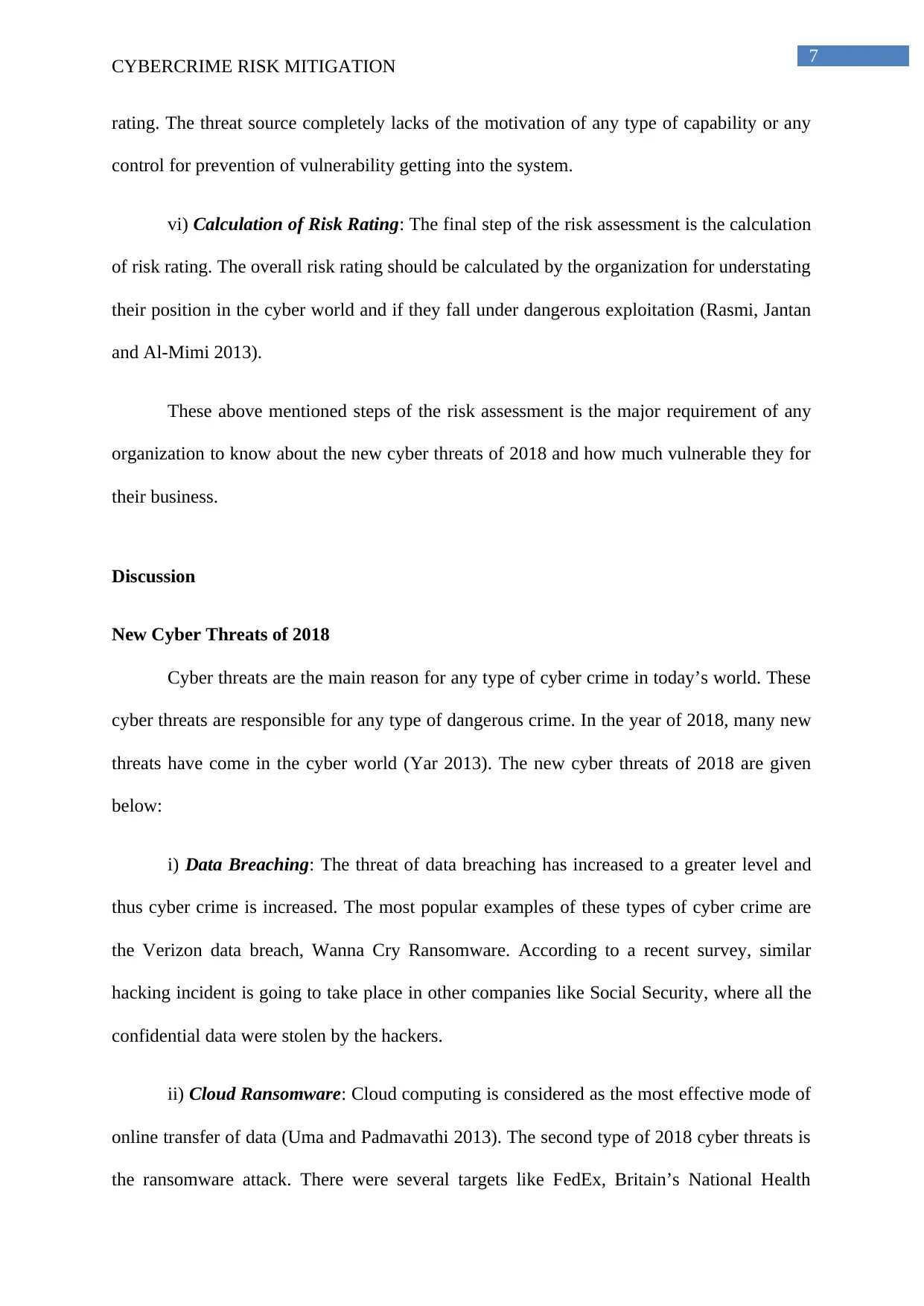
7
CYBERCRIME RISK MITIGATION
rating. The threat source completely lacks of the motivation of any type of capability or any
control for prevention of vulnerability getting into the system.
vi) Calculation of Risk Rating: The final step of the risk assessment is the calculation
of risk rating. The overall risk rating should be calculated by the organization for understating
their position in the cyber world and if they fall under dangerous exploitation (Rasmi, Jantan
and Al-Mimi 2013).
These above mentioned steps of the risk assessment is the major requirement of any
organization to know about the new cyber threats of 2018 and how much vulnerable they for
their business.
Discussion
New Cyber Threats of 2018
Cyber threats are the main reason for any type of cyber crime in today’s world. These
cyber threats are responsible for any type of dangerous crime. In the year of 2018, many new
threats have come in the cyber world (Yar 2013). The new cyber threats of 2018 are given
below:
i) Data Breaching: The threat of data breaching has increased to a greater level and
thus cyber crime is increased. The most popular examples of these types of cyber crime are
the Verizon data breach, Wanna Cry Ransomware. According to a recent survey, similar
hacking incident is going to take place in other companies like Social Security, where all the
confidential data were stolen by the hackers.
ii) Cloud Ransomware: Cloud computing is considered as the most effective mode of
online transfer of data (Uma and Padmavathi 2013). The second type of 2018 cyber threats is
the ransomware attack. There were several targets like FedEx, Britain’s National Health
CYBERCRIME RISK MITIGATION
rating. The threat source completely lacks of the motivation of any type of capability or any
control for prevention of vulnerability getting into the system.
vi) Calculation of Risk Rating: The final step of the risk assessment is the calculation
of risk rating. The overall risk rating should be calculated by the organization for understating
their position in the cyber world and if they fall under dangerous exploitation (Rasmi, Jantan
and Al-Mimi 2013).
These above mentioned steps of the risk assessment is the major requirement of any
organization to know about the new cyber threats of 2018 and how much vulnerable they for
their business.
Discussion
New Cyber Threats of 2018
Cyber threats are the main reason for any type of cyber crime in today’s world. These
cyber threats are responsible for any type of dangerous crime. In the year of 2018, many new
threats have come in the cyber world (Yar 2013). The new cyber threats of 2018 are given
below:
i) Data Breaching: The threat of data breaching has increased to a greater level and
thus cyber crime is increased. The most popular examples of these types of cyber crime are
the Verizon data breach, Wanna Cry Ransomware. According to a recent survey, similar
hacking incident is going to take place in other companies like Social Security, where all the
confidential data were stolen by the hackers.
ii) Cloud Ransomware: Cloud computing is considered as the most effective mode of
online transfer of data (Uma and Padmavathi 2013). The second type of 2018 cyber threats is
the ransomware attack. There were several targets like FedEx, Britain’s National Health
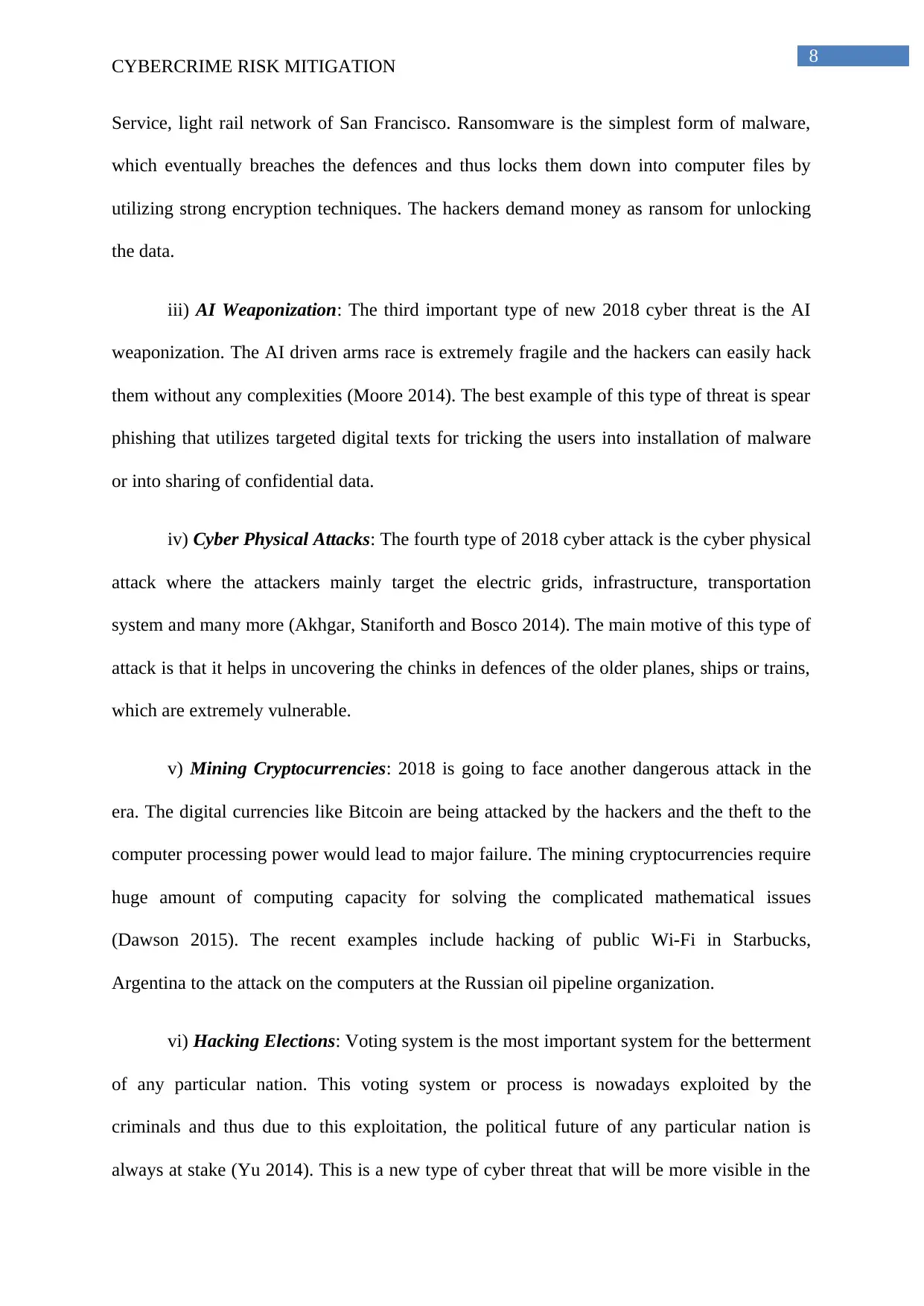
8
CYBERCRIME RISK MITIGATION
Service, light rail network of San Francisco. Ransomware is the simplest form of malware,
which eventually breaches the defences and thus locks them down into computer files by
utilizing strong encryption techniques. The hackers demand money as ransom for unlocking
the data.
iii) AI Weaponization: The third important type of new 2018 cyber threat is the AI
weaponization. The AI driven arms race is extremely fragile and the hackers can easily hack
them without any complexities (Moore 2014). The best example of this type of threat is spear
phishing that utilizes targeted digital texts for tricking the users into installation of malware
or into sharing of confidential data.
iv) Cyber Physical Attacks: The fourth type of 2018 cyber attack is the cyber physical
attack where the attackers mainly target the electric grids, infrastructure, transportation
system and many more (Akhgar, Staniforth and Bosco 2014). The main motive of this type of
attack is that it helps in uncovering the chinks in defences of the older planes, ships or trains,
which are extremely vulnerable.
v) Mining Cryptocurrencies: 2018 is going to face another dangerous attack in the
era. The digital currencies like Bitcoin are being attacked by the hackers and the theft to the
computer processing power would lead to major failure. The mining cryptocurrencies require
huge amount of computing capacity for solving the complicated mathematical issues
(Dawson 2015). The recent examples include hacking of public Wi-Fi in Starbucks,
Argentina to the attack on the computers at the Russian oil pipeline organization.
vi) Hacking Elections: Voting system is the most important system for the betterment
of any particular nation. This voting system or process is nowadays exploited by the
criminals and thus due to this exploitation, the political future of any particular nation is
always at stake (Yu 2014). This is a new type of cyber threat that will be more visible in the
CYBERCRIME RISK MITIGATION
Service, light rail network of San Francisco. Ransomware is the simplest form of malware,
which eventually breaches the defences and thus locks them down into computer files by
utilizing strong encryption techniques. The hackers demand money as ransom for unlocking
the data.
iii) AI Weaponization: The third important type of new 2018 cyber threat is the AI
weaponization. The AI driven arms race is extremely fragile and the hackers can easily hack
them without any complexities (Moore 2014). The best example of this type of threat is spear
phishing that utilizes targeted digital texts for tricking the users into installation of malware
or into sharing of confidential data.
iv) Cyber Physical Attacks: The fourth type of 2018 cyber attack is the cyber physical
attack where the attackers mainly target the electric grids, infrastructure, transportation
system and many more (Akhgar, Staniforth and Bosco 2014). The main motive of this type of
attack is that it helps in uncovering the chinks in defences of the older planes, ships or trains,
which are extremely vulnerable.
v) Mining Cryptocurrencies: 2018 is going to face another dangerous attack in the
era. The digital currencies like Bitcoin are being attacked by the hackers and the theft to the
computer processing power would lead to major failure. The mining cryptocurrencies require
huge amount of computing capacity for solving the complicated mathematical issues
(Dawson 2015). The recent examples include hacking of public Wi-Fi in Starbucks,
Argentina to the attack on the computers at the Russian oil pipeline organization.
vi) Hacking Elections: Voting system is the most important system for the betterment
of any particular nation. This voting system or process is nowadays exploited by the
criminals and thus due to this exploitation, the political future of any particular nation is
always at stake (Yu 2014). This is a new type of cyber threat that will be more visible in the
⊘ This is a preview!⊘
Do you want full access?
Subscribe today to unlock all pages.

Trusted by 1+ million students worldwide
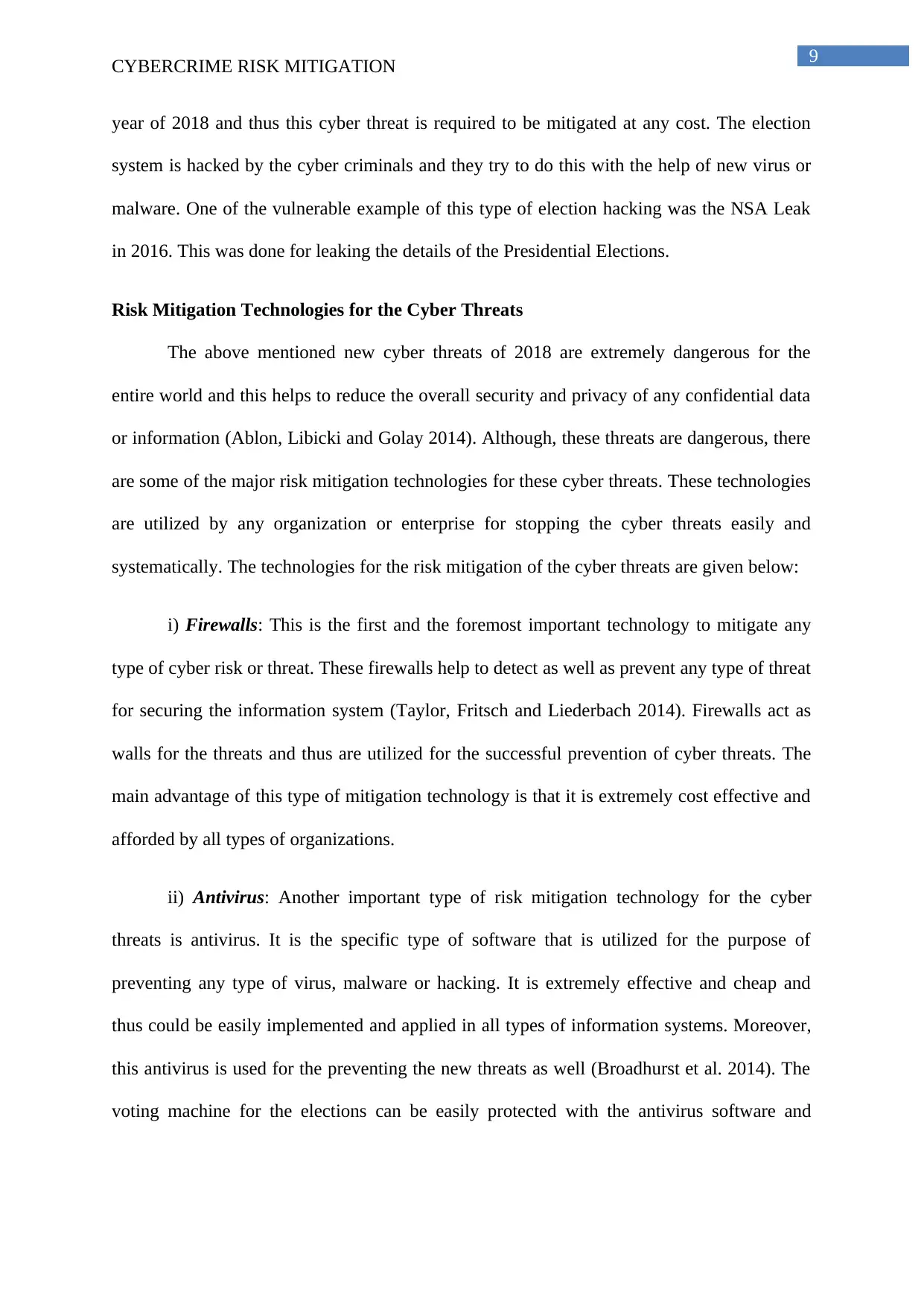
9
CYBERCRIME RISK MITIGATION
year of 2018 and thus this cyber threat is required to be mitigated at any cost. The election
system is hacked by the cyber criminals and they try to do this with the help of new virus or
malware. One of the vulnerable example of this type of election hacking was the NSA Leak
in 2016. This was done for leaking the details of the Presidential Elections.
Risk Mitigation Technologies for the Cyber Threats
The above mentioned new cyber threats of 2018 are extremely dangerous for the
entire world and this helps to reduce the overall security and privacy of any confidential data
or information (Ablon, Libicki and Golay 2014). Although, these threats are dangerous, there
are some of the major risk mitigation technologies for these cyber threats. These technologies
are utilized by any organization or enterprise for stopping the cyber threats easily and
systematically. The technologies for the risk mitigation of the cyber threats are given below:
i) Firewalls: This is the first and the foremost important technology to mitigate any
type of cyber risk or threat. These firewalls help to detect as well as prevent any type of threat
for securing the information system (Taylor, Fritsch and Liederbach 2014). Firewalls act as
walls for the threats and thus are utilized for the successful prevention of cyber threats. The
main advantage of this type of mitigation technology is that it is extremely cost effective and
afforded by all types of organizations.
ii) Antivirus: Another important type of risk mitigation technology for the cyber
threats is antivirus. It is the specific type of software that is utilized for the purpose of
preventing any type of virus, malware or hacking. It is extremely effective and cheap and
thus could be easily implemented and applied in all types of information systems. Moreover,
this antivirus is used for the preventing the new threats as well (Broadhurst et al. 2014). The
voting machine for the elections can be easily protected with the antivirus software and
CYBERCRIME RISK MITIGATION
year of 2018 and thus this cyber threat is required to be mitigated at any cost. The election
system is hacked by the cyber criminals and they try to do this with the help of new virus or
malware. One of the vulnerable example of this type of election hacking was the NSA Leak
in 2016. This was done for leaking the details of the Presidential Elections.
Risk Mitigation Technologies for the Cyber Threats
The above mentioned new cyber threats of 2018 are extremely dangerous for the
entire world and this helps to reduce the overall security and privacy of any confidential data
or information (Ablon, Libicki and Golay 2014). Although, these threats are dangerous, there
are some of the major risk mitigation technologies for these cyber threats. These technologies
are utilized by any organization or enterprise for stopping the cyber threats easily and
systematically. The technologies for the risk mitigation of the cyber threats are given below:
i) Firewalls: This is the first and the foremost important technology to mitigate any
type of cyber risk or threat. These firewalls help to detect as well as prevent any type of threat
for securing the information system (Taylor, Fritsch and Liederbach 2014). Firewalls act as
walls for the threats and thus are utilized for the successful prevention of cyber threats. The
main advantage of this type of mitigation technology is that it is extremely cost effective and
afforded by all types of organizations.
ii) Antivirus: Another important type of risk mitigation technology for the cyber
threats is antivirus. It is the specific type of software that is utilized for the purpose of
preventing any type of virus, malware or hacking. It is extremely effective and cheap and
thus could be easily implemented and applied in all types of information systems. Moreover,
this antivirus is used for the preventing the new threats as well (Broadhurst et al. 2014). The
voting machine for the elections can be easily protected with the antivirus software and
Paraphrase This Document
Need a fresh take? Get an instant paraphrase of this document with our AI Paraphraser
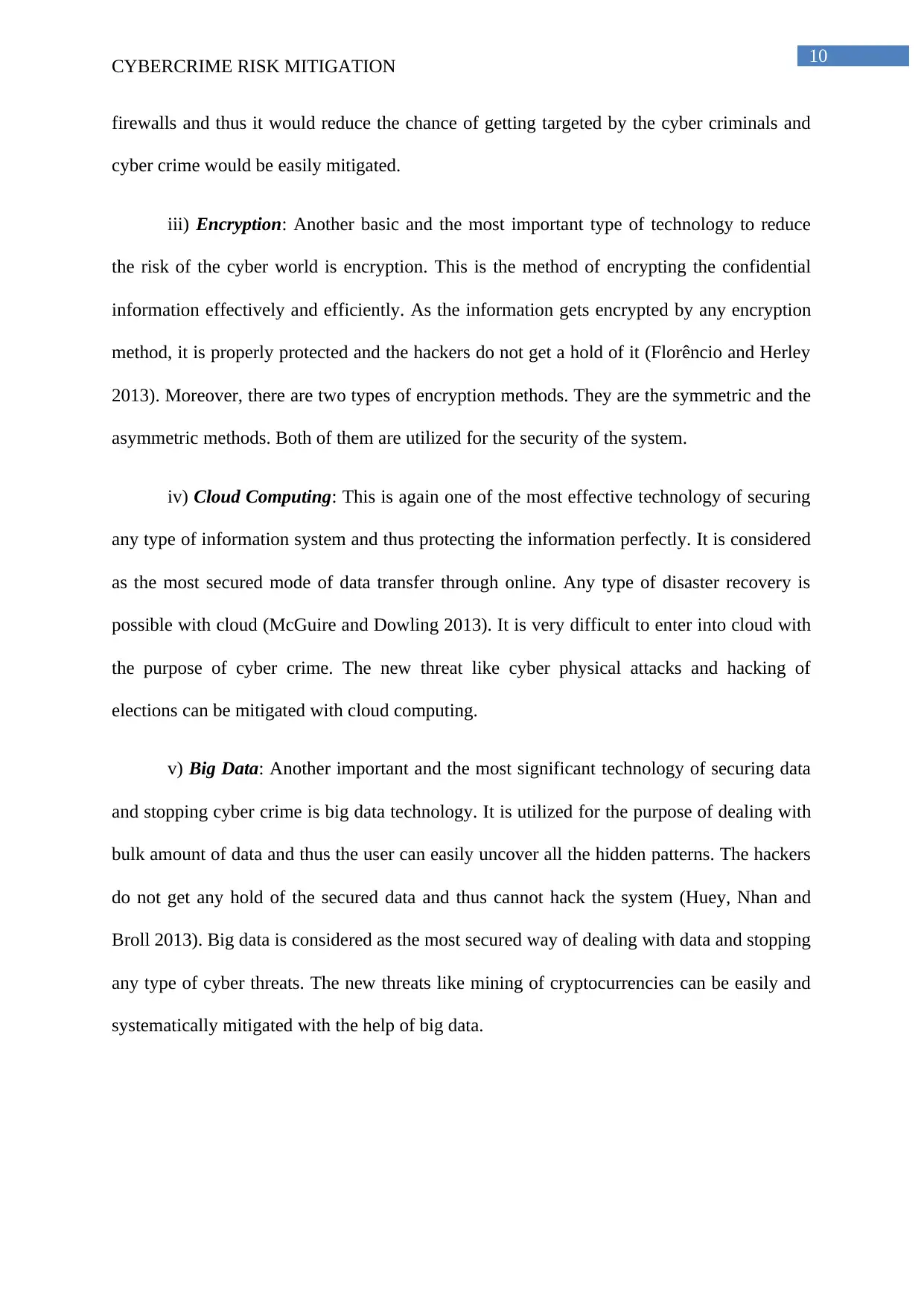
10
CYBERCRIME RISK MITIGATION
firewalls and thus it would reduce the chance of getting targeted by the cyber criminals and
cyber crime would be easily mitigated.
iii) Encryption: Another basic and the most important type of technology to reduce
the risk of the cyber world is encryption. This is the method of encrypting the confidential
information effectively and efficiently. As the information gets encrypted by any encryption
method, it is properly protected and the hackers do not get a hold of it (Florêncio and Herley
2013). Moreover, there are two types of encryption methods. They are the symmetric and the
asymmetric methods. Both of them are utilized for the security of the system.
iv) Cloud Computing: This is again one of the most effective technology of securing
any type of information system and thus protecting the information perfectly. It is considered
as the most secured mode of data transfer through online. Any type of disaster recovery is
possible with cloud (McGuire and Dowling 2013). It is very difficult to enter into cloud with
the purpose of cyber crime. The new threat like cyber physical attacks and hacking of
elections can be mitigated with cloud computing.
v) Big Data: Another important and the most significant technology of securing data
and stopping cyber crime is big data technology. It is utilized for the purpose of dealing with
bulk amount of data and thus the user can easily uncover all the hidden patterns. The hackers
do not get any hold of the secured data and thus cannot hack the system (Huey, Nhan and
Broll 2013). Big data is considered as the most secured way of dealing with data and stopping
any type of cyber threats. The new threats like mining of cryptocurrencies can be easily and
systematically mitigated with the help of big data.
CYBERCRIME RISK MITIGATION
firewalls and thus it would reduce the chance of getting targeted by the cyber criminals and
cyber crime would be easily mitigated.
iii) Encryption: Another basic and the most important type of technology to reduce
the risk of the cyber world is encryption. This is the method of encrypting the confidential
information effectively and efficiently. As the information gets encrypted by any encryption
method, it is properly protected and the hackers do not get a hold of it (Florêncio and Herley
2013). Moreover, there are two types of encryption methods. They are the symmetric and the
asymmetric methods. Both of them are utilized for the security of the system.
iv) Cloud Computing: This is again one of the most effective technology of securing
any type of information system and thus protecting the information perfectly. It is considered
as the most secured mode of data transfer through online. Any type of disaster recovery is
possible with cloud (McGuire and Dowling 2013). It is very difficult to enter into cloud with
the purpose of cyber crime. The new threat like cyber physical attacks and hacking of
elections can be mitigated with cloud computing.
v) Big Data: Another important and the most significant technology of securing data
and stopping cyber crime is big data technology. It is utilized for the purpose of dealing with
bulk amount of data and thus the user can easily uncover all the hidden patterns. The hackers
do not get any hold of the secured data and thus cannot hack the system (Huey, Nhan and
Broll 2013). Big data is considered as the most secured way of dealing with data and stopping
any type of cyber threats. The new threats like mining of cryptocurrencies can be easily and
systematically mitigated with the help of big data.
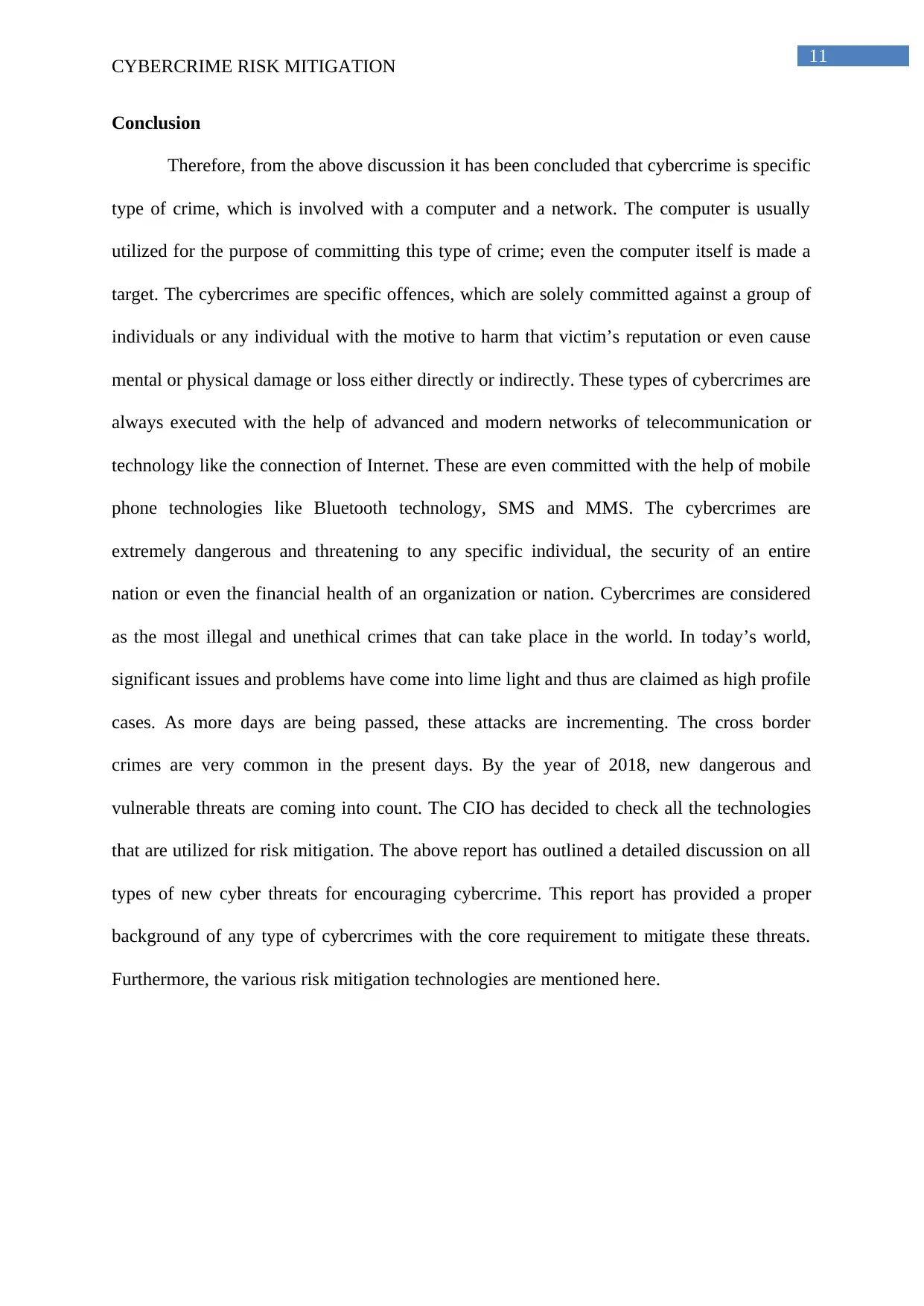
11
CYBERCRIME RISK MITIGATION
Conclusion
Therefore, from the above discussion it has been concluded that cybercrime is specific
type of crime, which is involved with a computer and a network. The computer is usually
utilized for the purpose of committing this type of crime; even the computer itself is made a
target. The cybercrimes are specific offences, which are solely committed against a group of
individuals or any individual with the motive to harm that victim’s reputation or even cause
mental or physical damage or loss either directly or indirectly. These types of cybercrimes are
always executed with the help of advanced and modern networks of telecommunication or
technology like the connection of Internet. These are even committed with the help of mobile
phone technologies like Bluetooth technology, SMS and MMS. The cybercrimes are
extremely dangerous and threatening to any specific individual, the security of an entire
nation or even the financial health of an organization or nation. Cybercrimes are considered
as the most illegal and unethical crimes that can take place in the world. In today’s world,
significant issues and problems have come into lime light and thus are claimed as high profile
cases. As more days are being passed, these attacks are incrementing. The cross border
crimes are very common in the present days. By the year of 2018, new dangerous and
vulnerable threats are coming into count. The CIO has decided to check all the technologies
that are utilized for risk mitigation. The above report has outlined a detailed discussion on all
types of new cyber threats for encouraging cybercrime. This report has provided a proper
background of any type of cybercrimes with the core requirement to mitigate these threats.
Furthermore, the various risk mitigation technologies are mentioned here.
CYBERCRIME RISK MITIGATION
Conclusion
Therefore, from the above discussion it has been concluded that cybercrime is specific
type of crime, which is involved with a computer and a network. The computer is usually
utilized for the purpose of committing this type of crime; even the computer itself is made a
target. The cybercrimes are specific offences, which are solely committed against a group of
individuals or any individual with the motive to harm that victim’s reputation or even cause
mental or physical damage or loss either directly or indirectly. These types of cybercrimes are
always executed with the help of advanced and modern networks of telecommunication or
technology like the connection of Internet. These are even committed with the help of mobile
phone technologies like Bluetooth technology, SMS and MMS. The cybercrimes are
extremely dangerous and threatening to any specific individual, the security of an entire
nation or even the financial health of an organization or nation. Cybercrimes are considered
as the most illegal and unethical crimes that can take place in the world. In today’s world,
significant issues and problems have come into lime light and thus are claimed as high profile
cases. As more days are being passed, these attacks are incrementing. The cross border
crimes are very common in the present days. By the year of 2018, new dangerous and
vulnerable threats are coming into count. The CIO has decided to check all the technologies
that are utilized for risk mitigation. The above report has outlined a detailed discussion on all
types of new cyber threats for encouraging cybercrime. This report has provided a proper
background of any type of cybercrimes with the core requirement to mitigate these threats.
Furthermore, the various risk mitigation technologies are mentioned here.
⊘ This is a preview!⊘
Do you want full access?
Subscribe today to unlock all pages.

Trusted by 1+ million students worldwide
1 out of 15
Related Documents
Your All-in-One AI-Powered Toolkit for Academic Success.
+13062052269
info@desklib.com
Available 24*7 on WhatsApp / Email
![[object Object]](/_next/static/media/star-bottom.7253800d.svg)
Unlock your academic potential
Copyright © 2020–2025 A2Z Services. All Rights Reserved. Developed and managed by ZUCOL.





